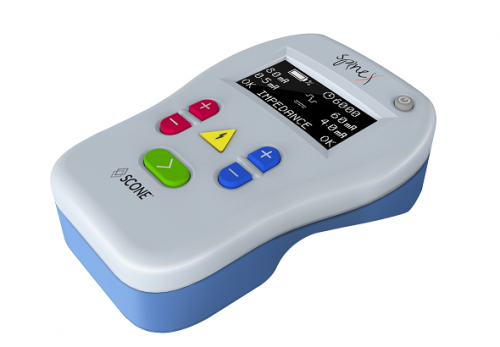In conversation with Praxis SCI Accelerate cohort member SpineX

SpineX Co-Founder and CEO Parag Gad talks with us about SCONE™, a noninvasive neuromodulation technology that leverages cutting-edge laboratory research to aid recovery and restoration of bladder, bowel, respiration, sexual and sensorimotor function.
What led you here in terms of education, experience, and people you met along the way?
I believe that spinal cord injury is a problem that can be solved by engineering technologies.
I’m a bioengineer by training and think of the body as a machine with multiple redundancies built into it. In May 2013, I finished a PhD in Biomedical Engineering at UCLA. From there, working with Dr. Reggie Edgerton, Co-Founder of SpineX, was a natural transition from being a researcher to being in the field doing justice for the patients.
SpineX is run by a small but passionate team led by Dr. Edgerton, who is considered the ‘father of modern spinal neuromodulation.’ Over the past 25 years, he has personally mentored almost every individual developing neuromodulatory strategies related to spinal cord injury.
Working together, the glue for us is in striving towards a common goal. We want to find a modality to help people with spinal cord injury. It’s been driving us for the last decade at least. Our vision for the company is to build devices that are synergistic to patients and ones that can allow us to treat the human body as one organism rather than individual organs.
The stimulator technology acts like a hearing aid, so individuals can empty their bladder by sensation. It also makes them less spastic, reduces the size and frequency of leaks and increases bladder capacity. The result is improved overall bladder control and quality of life. It’s a global change here.
Tell us about your customers. What do they need, and how are they challenged in their current situation?
One of the highest priorities for people living with spinal cord injury is improvement in bladder and bowel function. This also has the biggest impact on their quality of life. People with spinal cord injury lose their ability to sense a full bladder. They empty their bladder by a clock and, if not emptied in time, their bladder will leak. On top of that, the bladder has low capacity.
Medications are effective in a small percentage of individuals and come with significant side effects. These side effects reduce compliance in taking the medications.
What these individuals need is a low-cost, low-risk therapy that addresses the actual problem rather than managing symptoms to improve overall bladder health and, therefore, quality of life. To address this, SpineX developed SCONE™, a spinal neuromodulator platform technology delivering proprietary waveforms of varying current to designated areas of the spine. SCONE does this in a specific sequence through hydrogel electrodes placed directly over the skin without causing any pain or discomfort to patients in a completely non-surgical manner. The stimulator technology acts like a hearing aid, so individuals can empty their bladder by sensation. It also makes them less spastic, reduces the size and frequency of leaks and increases bladder capacity. The result is improved overall bladder control and quality of life. It’s a global change here.

SCONE™ spinal cord neuromodulator (pictured above) has been recognized by FDA as a Breakthrough Device.
Tell us about your vision for your company?
The long-term vision is we change the pattern for people, so they’ll be off catheterization altogether and eliminate urinary tract infection (UTI) risk. We realized that we cannot depend on others to get this core technology to market. That was one of the key motivations that led to the formation of SpineX. For this technology to really have an impact, it has to be done commercially.
From a commercialization point of view, we have an advantage. Because the technology is non-invasive, the risk is minimal. In comparison to other technologies, none are approved for use in spinal cord injury.
Our objectives are to have this available for clinic and home use. For regulatory approvals, the clinical device has a lower bar. For home, the potential risks are much higher with stringent assessments. But to make an impact it needs to be a home-based device. We’re making it in two steps: first for the clinic, then home use.
SCONE has been recognized by the FDA as a Breakthrough Device. We’re hoping to initiate the pivotal studies for FDA clearance by early next year and we’re on course to meet the timeline.
